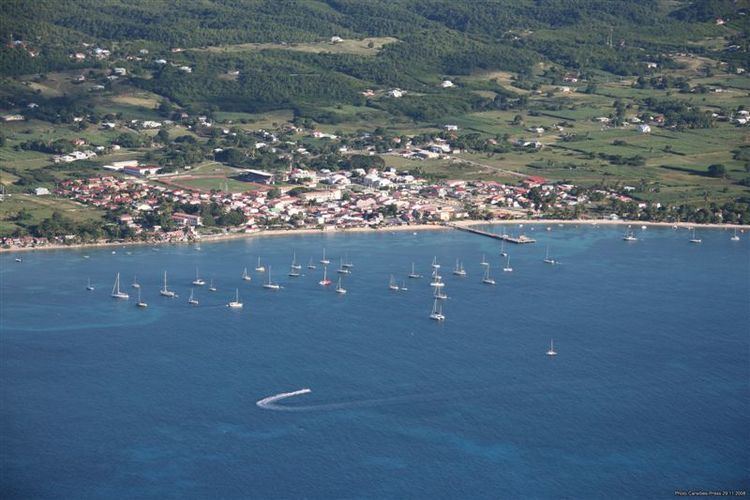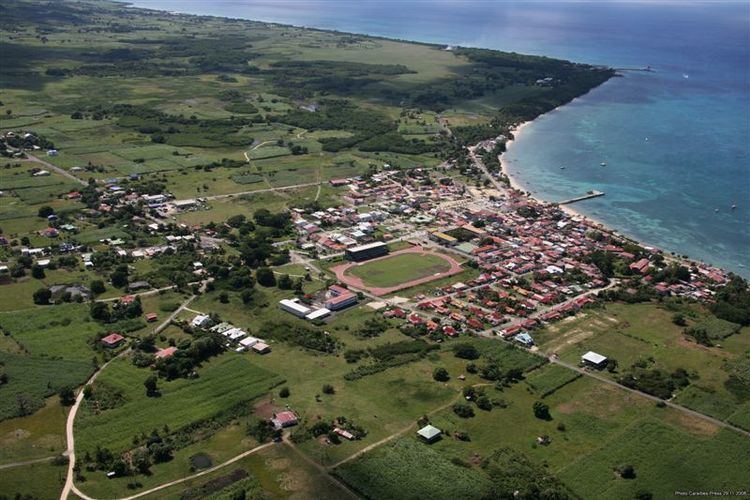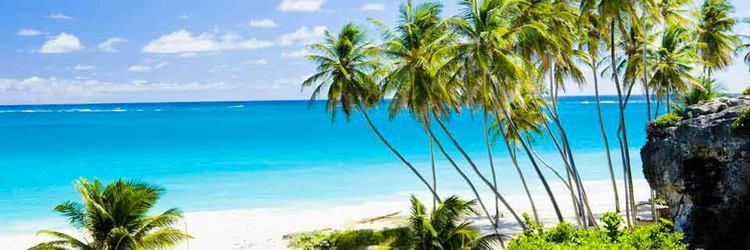Area 158 km² | ||
 | ||
Map of Marie-Galante
Marie-Galante is an island of the Caribbean Sea located south of Guadeloupe and north of Dominica. It is a dependency of Guadeloupe, which is an overseas department and an overseas region of France.
Contents
- Map of Marie Galante
- Marie galante the small unexploited caribbean gem in the french antilles
- Trailer marie galante
- AdministrationEdit
- HistoryEdit
- GeographyEdit
- EconomyEdit
- DemographyEdit
- PeopleEdit
- References

Marie-Galante has a land area of 170.5 km² (61 sq. miles). It had 11,528 inhabitants at the start of 2013, with a population density of 67.6 people per km².

Marie galante the small unexploited caribbean gem in the french antilles
Trailer marie galante
AdministrationEdit

Marie-Galante is divided into three communes (with populations at 1 January 2013):

These three communes formed an intercommunal entity in 1994: the Community of Communes of Marie-Galante (French: communauté de communes de Marie-Galante). This is the oldest intercommunal structure of the overseas regions of France.
HistoryEdit
The Huecoids are the oldest known civilizations to have occupied Marie-Galante, followed by Arawaks, and then by the Island Caribs circa 850. The island was called Aichi by the Caribs and Touloukaera by the Arawaks.
Marie-Galante was the second island encountered by Christopher Columbus during his second voyage, after Dominica. On 3 November 1493, he anchored at the islet now called Anse Ballet in Grand-Bourg, and named the island in honor of the flagship Marigalante (‘gallant Mary’) of the second voyage.
On November 8, 1648, Governor Charles Houël du Petit Pré organized the first French colonization of the Americas: about fifty men lived near the site called Vieux Fort "Old Fort". Jacques de Boisseret bought the island back from the French Company of the Islands of America on September 4, 1649. In 1653, the Carib Indians slaughtered the few remaining colonists who had not surrendered to the harsh living conditions.
Sugarcane, which probably originated in India, had been imported to the French West Indies by Christopher Columbus. As sugar became a commodity, it was cultivated in Guadeloupe from 1654 by deported Brazilian colonists who created the first sugar plantations equipped with small ox-powered mills to crush the cane.
In 1660, at Basse-Terre Chateau, a peace treaty was signed in which the Caribs authorized the French and British to settle on the islands of Dominica and Saint Vincent. With the island now at peace, the availability of mill technology was developing into a plantation-based economy by using imported slaves from Africa.
In 1664, Madame de Boisseret gave up her rights to Marie-Galante to the Company of the West Indies, and the island then had its first four ox-powered mills. In 1665, her son Monsieur de Boisseret de Temericourt became the island's governor. The map of the island he established carries his coat of arms. During the second half of the 17th century, the first slaves were brought from Africa to Marie-Galante to cultivate plantations. In 1671, 57% of the inhabitants were black. Jewish Dutch exiles from Brazil also settled, bringing new methods for the cultivation of cane sugar.
In 1676, a Dutch fleet abducted the population and plundered its facilities. After the repopulation of the island, its new inhabitants were attacked for the third time by the Dutch and by the British in 1690 and 1691. These raids, which resulted in the destruction of the mills, the refineries and the depopulation of the island, caused the Governor-General of Martinique to forbid the re-population of the island until 1696. The British retook the island from 1759 to 1763.
Windmills were first seen in 1780. By 1830, 105 mills were put in place, half of which were still ox-drawn. Today, 72 mill towers are still standing. From November 1792 to 1794, Marie-Galante, which was Republican, separated itself from the royalist government of Guadeloupe. Slavery was first abolished in 1794.
The British captured Guadeloupe, and with it Marie-Galante, la Désirade, and all Guadaloupe's dependencies, in April 1794. The Treaty of Amiens in 1802 restored them to France. With the restoration, slavery too was reinstated in 1802.
In March 1808 the Royal Navy took possession of Marie-Galante to stop French privateers using its port. In August a small French force attempted to recapture the island but the British garrison, consisting of Royal Marines, augmented by Sir Alexander Cochrane's first Colonial Marines, newly recruited from escaped slaves of the island, and by some troops from the 1st West India Regiment, defeated and captured the French. The British returned the island to France in 1815.
Slavery finally came to an end in 1848, thanks to the combined efforts of abolitionists, such as Victor Schœlcher, and repeated slave revolts.
The legislative elections of June 24 and June 25, 1849, the first time former slaves were permitted to vote, were inflicted by the bloody violence of protesters which have risen up out of the black majority in response to ballot-rigging orchestrated by wealthy white plantation owners. Many black people were killed during these uprisings which led to the dumping of rum and sugar from the Pirogue plantation into a nearby pond. Today this pond is known as la mare au punch (‘the Punch Pond’) in memory of these tragic events.
Guadeloupe (Grande-Terre and Basse-Terre), along with its dependencies (Marie-Galante, Saint Martin, Saint Barthélemy, Îles des Saintes and la Désirade), were an overseas department since 1946 and a single-department overseas region since 1982. Within Marie-Galante the three communes are Capesterre-de-Marie-Galante, Grand-Bourg and Saint-Louis. Together, these were designated as an intercommunal entity on January 8, 1994, the first to be created in an overseas department. In 2007, Saint-Martin and Saint-Barthélemy each became an overseas collectivity, making them politically separate from Guadeloupe.
Steven Callahan, who was lost at sea in a small (5-foot, 6-inch inside diameter) Avon life raft for 76 days, was found alive on April 21, 1982 off the coast of Marie-Galante by local fishermen Paulinus Williams, Jules Paquet and Jean-Louis Paquet, from neighbouring Guadeloupe.
GeographyEdit
Marie-Galante comprises three communes of France: Grand-Bourg, Capesterre-de-Marie-Galante, and Saint-Louis, Guadeloupe, with a combined 1999 census population of 12,488 inhabitants. The island is more commonly known as la grande galette (‘the Big Biscuit’) due to its round shape and almost flat surface; its highest peak, the Morne Constant Hill, rises to 204 m. Formerly having over 106 sugar mills, it is also called "the Island of a Hundred Windmills" (French: lîle aux cent moulins). It is also nicknamed the Grande dépendance, being the biggest dependency of Guadeloupe. The island is undulating substrate calcareous, cooled by the trade winds and subject to cyclones and earthquakes.
The northern coast is characterized by a high cliff. A fault line called the "Bar" separates the northern quarter from the remainder of the island. To the west, beaches and mangroves extend along the Caribbean Sea. The rivers of Saint-Louis and the Vieux-Fort run through the plateau that sits at the center of Marie-Galante. In the East and the South, the plateau descends sharply to a coastal plain skirting the Atlantic Ocean from which it is protected by a barrier coral reef.
EconomyEdit
The colonial economy was based on the cultivation of tobacco, indigo, coffee and cotton. But from the 17th century, sugar cane became an important source of income. This continued into the 19th and 20th centuries, adapting to the abolition of slavery and the great sugar crisis.
During the dominance of the sugar cane industry, Marie-Galante acquired the nickname "the island with a hundred mills". In 1818 there were over one hundred mills to process sugar cane. The cane juice was transformed into sugar or rum. The mills were originally powered by oxen, replaced by windmills from 1780, in turn replaced by steam powered mills from 1883.
The 19th century brought the disappearance of the former economic model. Gradually the small-scale sugar refining was processed in larger factories, by 1885 the five sites controlled the industry. In 1931, eighteen sugar distilleries and four factories were in production. In the 20th century, the large plantations gave place to small farms, organized into co-operatives. But agriculture in the French West Indies is subject to global competition and by the beginning of the 21st century, one sugar refinery (usine de Grande-Anse) and three distilleries (Bellevue, Bielle, and Poisson) remained on Marie-Galante. The white rum they produced is subject to an appellation d'origine contrôlée. Organic sugar production could be an innovative development, but the current political situation ended European subsidies putting the current agricultural practices in jeopardy and thus threatens the economic future of Marie-Galante and its inhabitants.
Remnants of the old economy still exist and Marie-Galante's rich history is a tourist attraction: a nature trail with 70 points of interest including two restored windmills (the Bézard Mill and the Bellevue Distillery), colonial dwellings and old sugar refineries (the Murat House and Mill) produces a network of paths for hikers to discover the island and its people.
Like the other islands in the region, Marie-Galante has undergone the economic transformation accompanying tourism. But the tourism development is based on a policy of conserving nature and heritage, whether it is pre-Columbian, colonial or contemporary. Marie-Galante Airport is located on Pointe des Basses, halfway between Grand-Bourg and Capesterre making access to the airport difficult.
DemographyEdit
Marie-Galante had 30,000 inhabitants in 1946. There was an exodus for people going to Guadeloupe and France and the island had fewer than 12,009 inhabitants in the 2006 census. This population decline is related to the decrease in the sugar cane economy. The population density in 2006 was 76 people per km².
